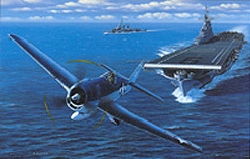|
|
| Off To The Turkey Shoot |
|
 |

|
 |
|
|
| DESCRIPTION |
 |
| 16 x 11.5 Inch Collector Size Unframed Lithograph $40.00
At the time of the attack of Pearl Harbor the Japanese had superior aircraft and plenty of experienced pilots fresh from combat in China. By 1944 the roles were reversed. Anxious to commence B-29 bombing missions against the Japanese homeland Rear Admiral Marc Mitscher's Task Force 58 was given the assignment of supporting the recapture of the Marianas. This proved to be the last major carrier battle of World War II. On June 11 1944 large formations of Hellcats were dispatched to lure Japanese land-based fighters into combat. Enough Japanese fighters were destroyed to allow the Fifth Fleet to land 140000 troops on Saipan and Guam on June 15th. Also on June 15th the Japanese main fleet joined up with its mobile fleet about 300-400 miles from Task Force 58. Vice Admiral Ozawa detached a force to use as bait to lure the Americans within range of the main fleet. His bait not taken on June 19th Ozawa launched three air strikes with about 250 aircraft. The relatively inexperienced Japanese pilots now flying technically inferior aircraft were decimated by the Grumman Hellcats of Task Force 58. By day's end Ozawa had lost 218 aircraft and while unprotected his fleet had been attacked by American submarines resulting in the sinking of two of his carriers. Late in the afternoon of June 20th American Hellcats Helldivers and Avengers were launched at Ozawa's fleet resulting in the loss of one more carrier and severe damage to another two. As his airwings returned after dark Admiral Mitscher ordered his fleet to light-up which enabled many of the American aircraft to return safely. About a third of the planes were forced to ditch with the loss of thirteen crewman. The Grumman F6F-5 Hellcat pictured in this dramatic original oil painting created exclusively for The Stokes Collection by Stan Stokes became the Navy's primary carrier borne fighter plane during World War II. Over 12000 Hellcats were produced and the Hellcat was credited with 4947 of the 6477 kills of enemy planes downed by carrier pilots during the War. The Hellcat had a top speed of 375 MPH a range of 1089 miles and was armed with six machine guns. The aircraft was powered by an 18-cylinder Pratt and Whitney air-cooled radial engine which generated 2000 horsepower. As depicted by Stokes is the aircraft of Squadron Commander David McCampbell of the USS Essex. McCampbell is the highest scoring US Naval aviator of all time. |
|


|